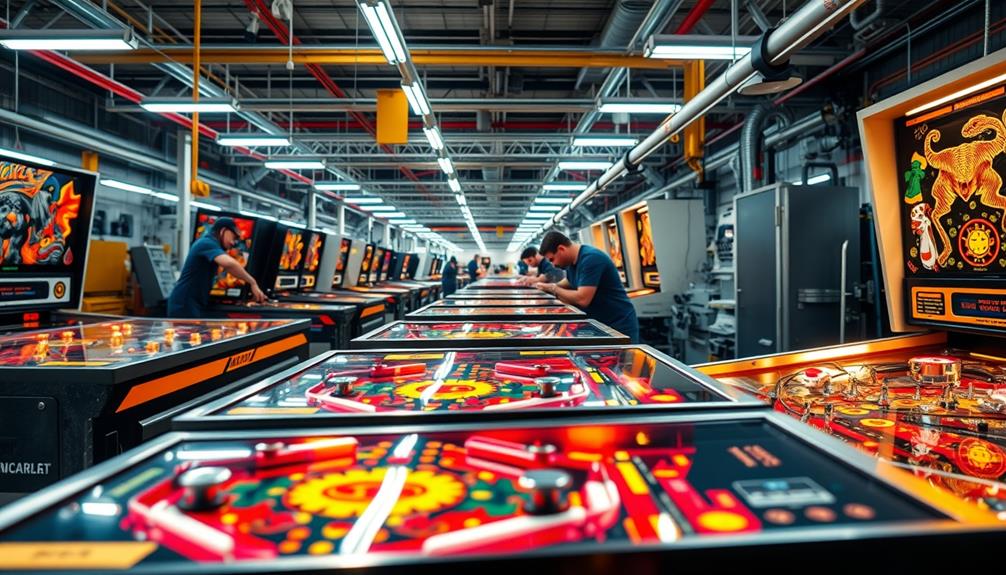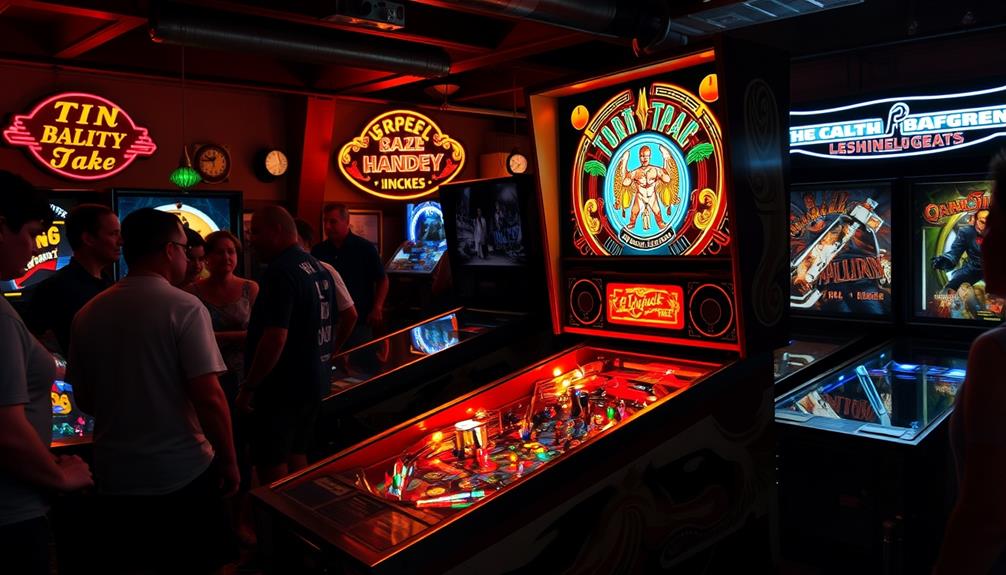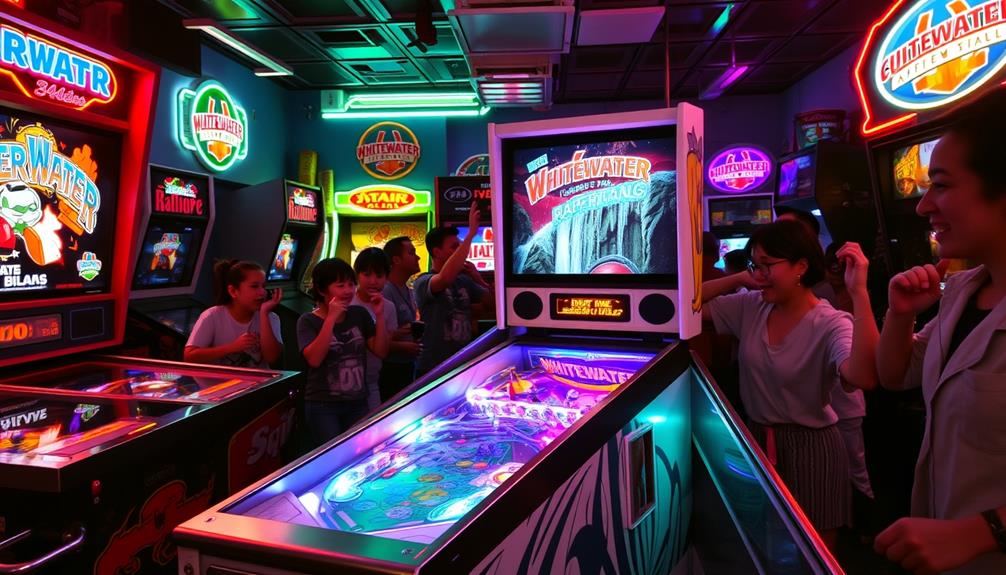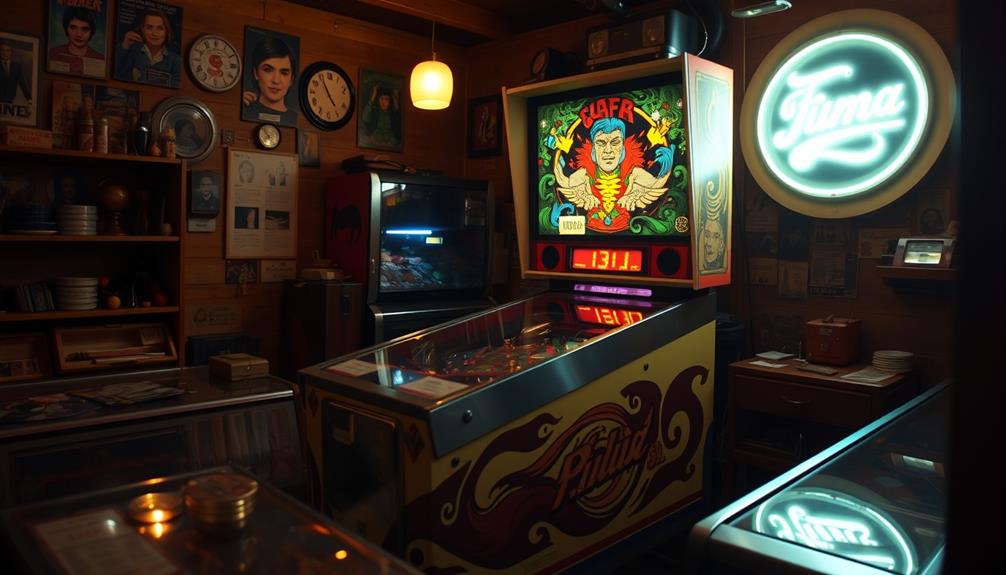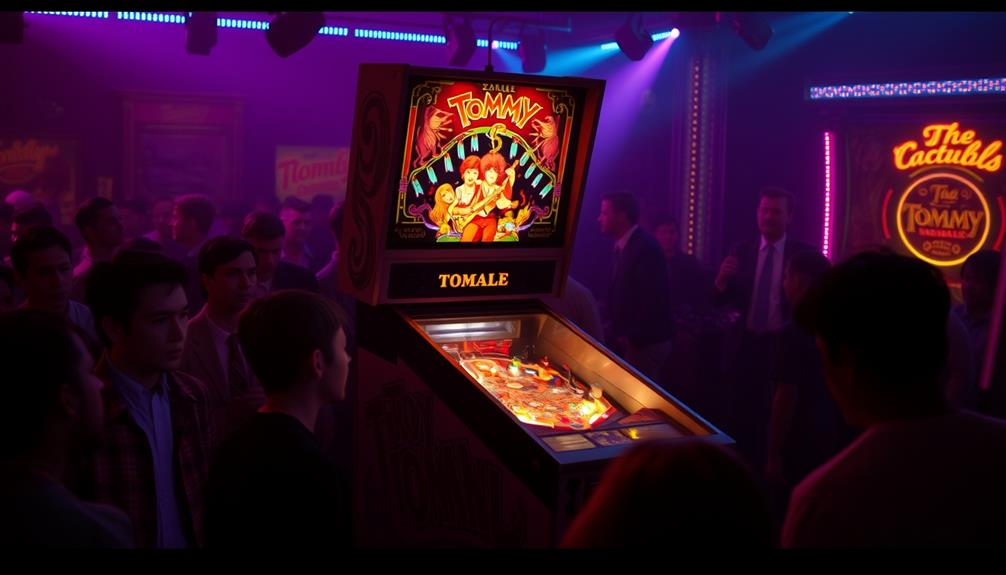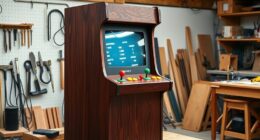Creating pinball machines is an engrossing procedure that involves a combination of design, engineering, and craftsmanship. It commences with dedicated teams crafting prototypes using sturdy materials such as plywood and stainless steel. Throughout several months, they fine-tune the game elements to provide the ultimate player experience. Skilled workers then meticulously assemble around 1,000 components, ensuring every detail meets stringent quality standards. The eye-catching art on the machines is achieved through silk-screen printing, adding vibrant visuals to the mix. Subsequently, thorough testing guarantees each machine’s reliability and entertainment value. The level of creativity infused into each game is truly astonishing, so be sure to stay tuned for more insights into the intricate process behind pinball production! The precision and attention to detail involved in the pinball machine assembly process are highlighted in the final product, a true testament to the dedication and expertise of the teams responsible for these iconic games. From initial concept to completion, the journey of pinball machine assembly is a captivating one that exemplifies the artistry and innovation underlying this beloved form of entertainment. The pinball machine assembly process requires precision and attention to detail, as each part must fit together perfectly to ensure smooth gameplay. The final product is a testament to the dedication and expertise of the teams involved in creating these iconic games. From concept to completion, the pinball machine assembly process is a fascinating journey that showcases the artistry and innovation behind this beloved form of entertainment.
Key Takeaways
- Pinball machines are designed collaboratively by teams of game designers, developers, and engineers over a 12-18 month prototyping period.
- The manufacturing process involves selecting durable materials like plywood, stainless steel, and molded plastic to ensure longevity and performance.
- Assembly requires skilled workers to fit together approximately 1,000 parts, including wiring and electronic components organized by color codes.
- Quality control is maintained through rigorous testing of prototypes and initial production runs to ensure reliability and safety.
- Artistic elements, such as unique themes and vibrant artwork, are integrated into the design to enhance player engagement and reflect cultural trends.
Origins of Pinball
Pinball's origins trace back to Bagatelle, a French marble game that captured the attention of the elite in the 1780s. This game laid the groundwork for what would evolve into modern pinball. When French soldiers introduced Bagatelle to the United States during the American Revolution, its popularity began to soar, leading to AI-powered virtual reality in e-learning as a new form of interactive entertainment.
By the 1830s, full-size pinball games started emerging across Europe and the U.S., incorporating various international adaptations of Bagatelle.
As pinball's history unfolded, it faced challenges. In the 1930s, the game was classified primarily as a game of chance, resulting in significant bans in major cities like Los Angeles and Chicago. However, the introduction of flippers in 1947 marked a pivotal moment in the gameplay, shifting the focus from mere chance to skill. This innovation not only revitalized interest in pinball but also set the stage for its resurgence in the late 20th century.
The evolution of pinball reflects a fascinating journey through manufacturing techniques and gameplay styles, transforming from a marble game into a beloved arcade staple that combines both skill and strategy.
Design and Prototyping

When you think about creating a new pinball game, the design and prototyping process is essential. It requires a blend of creativity and feasibility, much like the principles outlined in design thinking frameworks.
A dedicated team collaborates to bring concepts to life, ensuring every ramp and flipper is strategically placed for ideal gameplay.
You'll see how they build and test multiple prototypes to refine the design before moving into mass production.
Prototyping Process Overview
Creating a new pinball game is an intricate process that typically unfolds over 12-18 months, requiring collaboration among a diverse team of game designers, software developers, artists, mechanical engineers, and sound designers.
It all starts with an original idea that shapes the game's layout and playfield, focusing on the placement of elements like ramps and flippers. This high-quality content is crucial for attracting and retaining users, as the design team employs CAD software to create a whitewood prototype.
This prototype undergoes multiple revisions, ensuring that every part fits together perfectly and meets design specifications. Once the final design is complete, the team assembles 10-20 prototypes for rigorous testing.
Here's what happens during this phase:
- One prototype undergoes regular field testing to gauge real-world playability.
- Another is subjected to drop tests to check for sturdiness and durability.
- Feedback from testing can lead to adjustments, ensuring the game is both fun and safe.
After addressing any assembly issues, the prototypes are refined, paving the way for mass production.
This meticulous process is essential to creating a pinball machine that stands the test of time.
Design Team Collaboration
Throughout the design and prototyping phase, a tight-knit collaboration among team members is vital for bringing a pinball game to life. As a game designer, you'll work closely with a software developer, artist, mechanical engineer, and sound designer. Together, you'll brainstorm initial concepts, whether they're original ideas or licensed themes, to create an exciting playfield layout that includes ramps, flippers, and scoring elements.
This process mirrors the importance of effective preparation in interior design, where understanding client preferences can lead to more successful outcomes.
Once the initial ideas are set, the team employs CAD software to develop a whitewood prototype. This prototype undergoes multiple revisions and testing phases to guarantee everything fits and assembles correctly. The collaborative nature of this process means constant feedback from all team members, allowing for adjustments before moving into mass production.
After reaching a satisfactory design, you'll assemble 10-20 prototypes for rigorous testing. These prototypes are tested for playability, safety, and assembly issues, ensuring they meet specifications and player safety standards.
Each round of testing provides valuable insights that inform necessary design adjustments. Ultimately, this design team collaboration is vital for creating a successful pinball game that players will love.
Raw Materials Used

The materials that go into making a pinball machine play an essential role in its performance and longevity. To achieve this, manufacturers carefully select raw materials for pinball machines that balance cost, durability, and quality.
Understanding the importance of financial planning can also be vital for manufacturers as they invest in quality materials.
Key materials include:
- Durable plywood: The playfield is primarily crafted from this sturdy material to withstand the ball's impact.
- Stainless steel and aluminum: Critical metal components, like screws and springs, are made from these materials for their resistance to corrosion and longevity.
- Molded plastic: This is used for special playfield elements, enabling intricate designs and features that enhance gameplay.
Vendors supplying parts must adhere to exact specifications to guarantee compatibility and quality across all components.
While cost control measures often lead manufacturers to choose the cheapest materials, they must be careful not to compromise the integrity of machines.
This balance guarantees that the final product not only performs well but also stands the test of time, providing a reliable and enjoyable experience for players.
Manufacturing Process

When you look at how pinball machines are made, you'll find that raw material selection is the first critical step.
Manufacturers often prioritize durable materials to guarantee longevity, similar to the focus on energy efficiency and smart home integration seen in modern appliances.
Next, assembly line procedures come into play as skilled workers put together the thousands of parts.
Raw Material Selection
In crafting a pinball machine, selecting the right raw materials is essential to guarantee both durability and playability. The choice of materials greatly impacts the overall performance and lifespan of the machine.
This process can be likened to best practices in software quality assurance, where careful selection and systematic testing are vital to produce a reliable final product.
Here's a breakdown of key components in raw material selection:
- Plywood: The playfield is primarily made from sturdy plywood, providing a resilient surface for gameplay.
- Metal Components: Essential elements like screws and springs are crafted from stainless steel or aluminum to secure longevity and resistance to wear.
- Special Elements: Ramps and toys often utilize molded plastic, allowing for intricate designs and vibrant colors.
Manufacturers also prioritize cost control, often opting for the most affordable materials without compromising quality.
Silk-screen printing plays a vital role in creating stunning backglasses and playfield art. The artwork is broken into stencils and applied through a four-color process, yielding diverse color variations that enhance the visual appeal.
Assembly Line Procedures
While assembling a pinball machine, manufacturers meticulously coordinate around 1,000 parts, guaranteeing each component fits seamlessly into the overall design. The production process typically takes about 20-30 hours of labor, similar to the best vacuums for dust removal that require careful selection of components for peak performance.
The playfield, made from sturdy plywood, is crafted using automated high-pressure machines that efficiently incise the boards.
During assembly, over 750 meters of wire is organized with a color-coded system, securely attached through soldering and crimping processes. Foam strips are strategically used to protect the playfield from nail punctures, while metal templates guide the drilling for various gadget installations. Each part is essential for the machine's functionality, including the sound effects that enhance gameplay.
Before mass production begins, prototypes undergo rigorous quality control testing. These tests evaluate playability and durability, helping to identify and correct any assembly glitches.
This meticulous process guarantees that once the pinball machine moves into full manufacturing, it meets the high standards expected by players. With every detail carefully considered, the assembly line transforms raw materials into the thrilling pinball machines enjoyed by enthusiasts worldwide.
Quality Control Measures
Assembling a pinball machine involves a complex interplay of parts, but before mass production kicks off, quality control measures are put in place to confirm everything meets specified requirements.
The first step is the creation of prototypes, which serve as the main quality check. These prototypes are rigorously tested for playability, safety, and durability before any larger production runs are initiated. The attention to detail during this phase is essential; similar to how Blue Skies and Lemonade by Rhythm Failure captures a radiant essence, each component must be carefully crafted to guarantee a joyful gaming experience.
To facilitate a smooth shift to mass production, several key quality control steps are followed:
- Inspection of Components: Each part must meet strict criteria upon arrival, preventing issues later in assembly.
- Prototype Feedback: Evaluations from prototype testing provide vital insights, allowing for necessary modifications in the manufacturing process.
- Initial Production Run: A small batch of 50-100 games is produced post-inspection to verify the production line's readiness and facilitate final adjustments.
These measures not only enhance the overall quality and functionality of the pinball machines but also confirm that any assembly glitches are identified early, leading to a more reliable final product.
Quality Control Measures
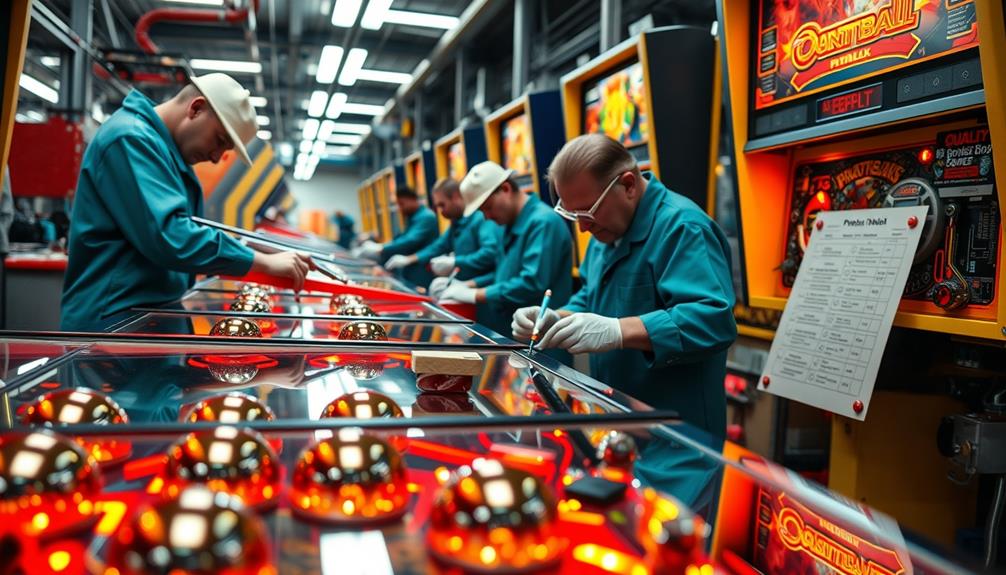
Quality control measures play an essential role in the production of pinball machines, guaranteeing that each component meets strict specifications before mass production begins. These measures start with testing prototypes, which are vital for identifying potential issues like playability and safety. Through rigorous evaluations, manufacturers can pinpoint assembly glitches and necessary adjustments.
Here's a breakdown of the quality control process:
| Stage | Purpose | Outcome |
|---|---|---|
| Prototype Testing | Assess playability and safety | Identify issues |
| Specification Check | Verify parts meet design requirements | Validate consistency |
| Initial Run | Produce 50-100 games for final testing | Confirm production line |
| Feedback Review | Gather insights from initial tests | Inform production decisions |
| Adjustments | Implement changes based on evaluations | Improve future production |
After the initial run, feedback is vital for refining the manufacturing process. Adjustments based on this feedback guarantee that any issues raised during prototype evaluations are addressed before moving forward. This commitment to quality control assures a reliable and enjoyable pinball experience for players.
Key Components Overview
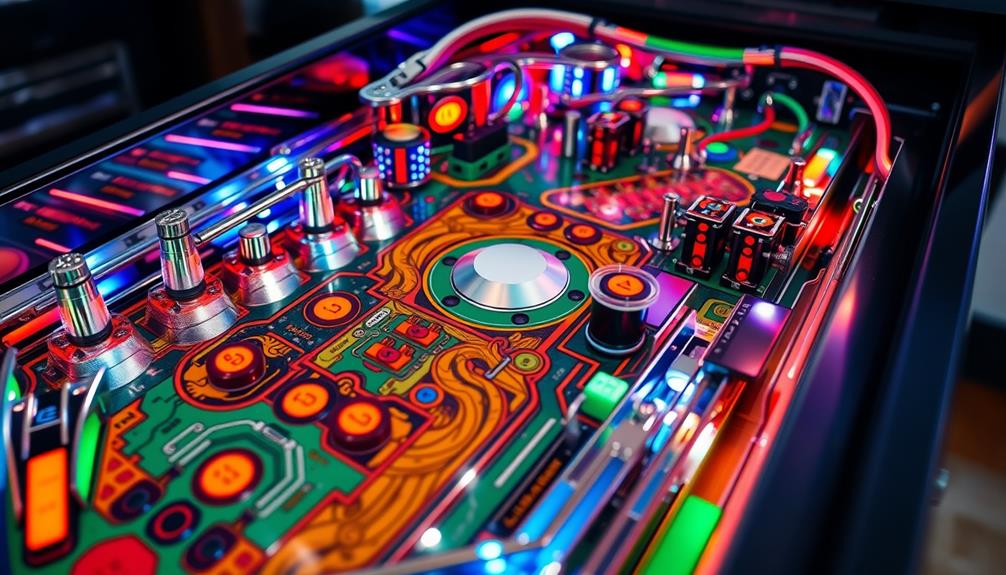
Pinball machines are complex creations that rely on a variety of vital components to deliver an exciting gaming experience. These elements work together to engage players and enhance gameplay.
For instance, understanding the mechanics of the game can enhance your enjoyment just like mastering different brewing methods can elevate your coffee experience. Here's a quick overview of some essential components:
- Bumpers and Flippers: These are essential for player interaction, allowing you to control the ball's movement and keep it in play.
- Ramps and Targets: Ramps guide the ball to scoring areas, while targets present challenges that release bonuses and multipliers.
- Digital Displays: Modern machines use these for scoring, replacing vintage mechanical score reels and keeping track of high scores.
Additionally, multiball mechanisms ramp up the excitement by letting multiple balls be in play at once.
Coupled with vibrant lighting effects—often featuring up to 115 flashing lights—and immersive sound effects from onboard speakers, the atmosphere becomes electrifying.
You'll find these components effectively working together to create an engaging experience focused on scoring and gameplay.
Wiring and Electronics

Connecting a pinball machine's wiring and electronics is essential for guaranteeing all components work seamlessly together. A single machine uses over 750 meters of wire, organized by color codes for easy identification. This wiring system connects various components, like switches and circuit boards, playing a significant role in the gameplay mechanics.
Each game can feature up to 70 switches, all meticulously wired to enhance the scoring systems. To guarantee reliability, wires are attached to connectors on circuit boards through soldering and crimping processes. This secure connection is critical for performance, especially when it comes to features like sound effects and flashing lights that elevate the gaming experience.
Before final assembly, technicians utilize testing boards to check every circuit within the machine. This step is significant for identifying potential issues and guaranteeing that everything functions as intended. Proper installation and connection of all wiring components are key to creating a smooth, engaging gameplay experience.
When everything's in place, the pinball machine springs to life, ready for players to enjoy.
Industry Impact
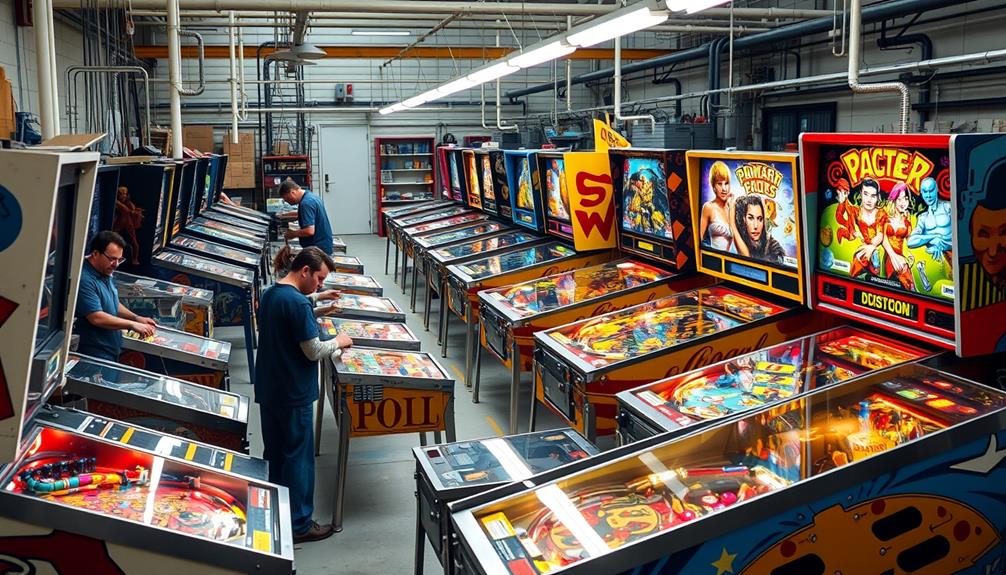
The impact of pinball on social entertainment venues can't be overstated. Since the 1930s, pinball machines became staples in taverns, drugstores, and barbershops, shaping how people interacted and enjoyed leisure time. Major manufacturers like Bally and Gottlieb not only thrived during the Great Depression but also showcased the resilience of this industry.
Here are a few key aspects of pinball's industry impact:
- Manufacturing Growth: Over 100 companies entered the market in the early 1930s, leading to an explosion in production and innovation.
- Design Team Innovations: With the resurgence of pinball in the 1970s, design teams pushed boundaries, creating exciting prototypes that combined art and mechanics.
- Quality Control Evolution: As the industry evolved, so did quality control measures, ensuring that each pinball machine met high standards, especially against the backdrop of competition from video games.
Despite fluctuations in legal status and market challenges, pinball's enduring appeal has kept it relevant. Its resurgence has revitalized the industry, proving that a well-crafted pinball machine can still captivate players and serve as a social hub.
Artistic Evolution
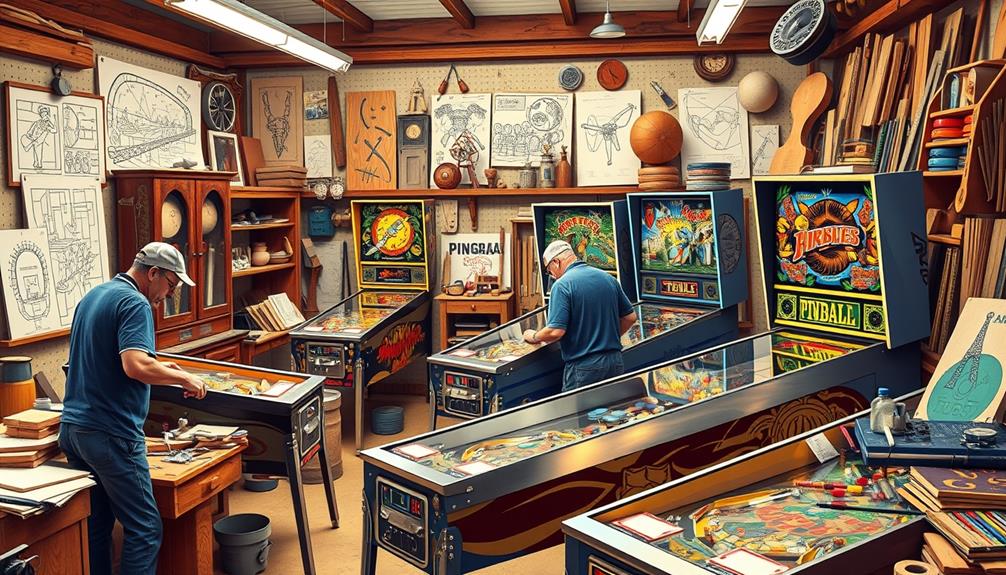
As the pinball industry flourished, artistry began to play a pivotal role in enhancing the player experience. The 1970s marked a significant shift, with vibrant backglass art and imaginative playing field art enchanting players. A dedicated design team worked tirelessly to create visually appealing machines, making each game a unique piece of art.
With the introduction of microchip technology in the late 1970s, gameplay evolved dramatically. This innovation allowed for advanced scoring systems and memory features, leading to more intricate and engaging experiences. Plus, sound designers incorporated speech capabilities and enhanced sound effects, further enriching the artistic elements of pinball machines.
However, as video games rose in popularity during the early 1980s, manufacturers produced simplified versions of pinball machines to cut costs while still maintaining artistic value.
Fortunately, the revival of interest in vintage pinball machines and home arcade collections has reignited a focus on artistic design. Modern designers are now collaborating with players, ensuring that artistry continues to thrive in the pinball world, blending nostalgia with contemporary creativity.
This artistic evolution shapes your gameplay experience, making each session a memorable adventure.
Frequently Asked Questions
What Is the Ball in a Pinball Machine Made Of?
The ball in a pinball machine's made of solid steel, providing weight and durability. It measures about 1.125 inches in diameter, ensuring it rolls smoothly and interacts effectively with the machine's components during gameplay.
Why Was Pinball Not Legal?
Imagine a world where youth found joy in games, yet pinball's association with crime and chance led to its prohibition. It wasn't until skill emerged with flippers that perceptions shifted and legality returned.
How Are Pinball Backglass Made?
You'll find pinball backglasses are crafted using silk-screen printing, employing stencils for each color layer. This process guarantees vibrant graphics that enhance the machine's look while displaying essential game information effectively.
What Materials Are Used in Pinball Machines?
Pinball machines use durable plywood for playfields, stainless steel or aluminum for metal parts, and molded plastic for special features. Silk-screen printing adds vibrant designs to backglasses and playfields, enhancing your gaming experience.
Conclusion
In summary, the journey of pinball machines from concept to reality is an engaging blend of art and engineering. Did you know that around 3,000 individual parts can go into a single pinball machine? This fact highlights the intricate craftsmanship involved in each game. As you've learned, every component plays an essential role in creating that thrilling experience, ensuring pinball remains a beloved pastime that continues to evolve while enchanting players worldwide.
